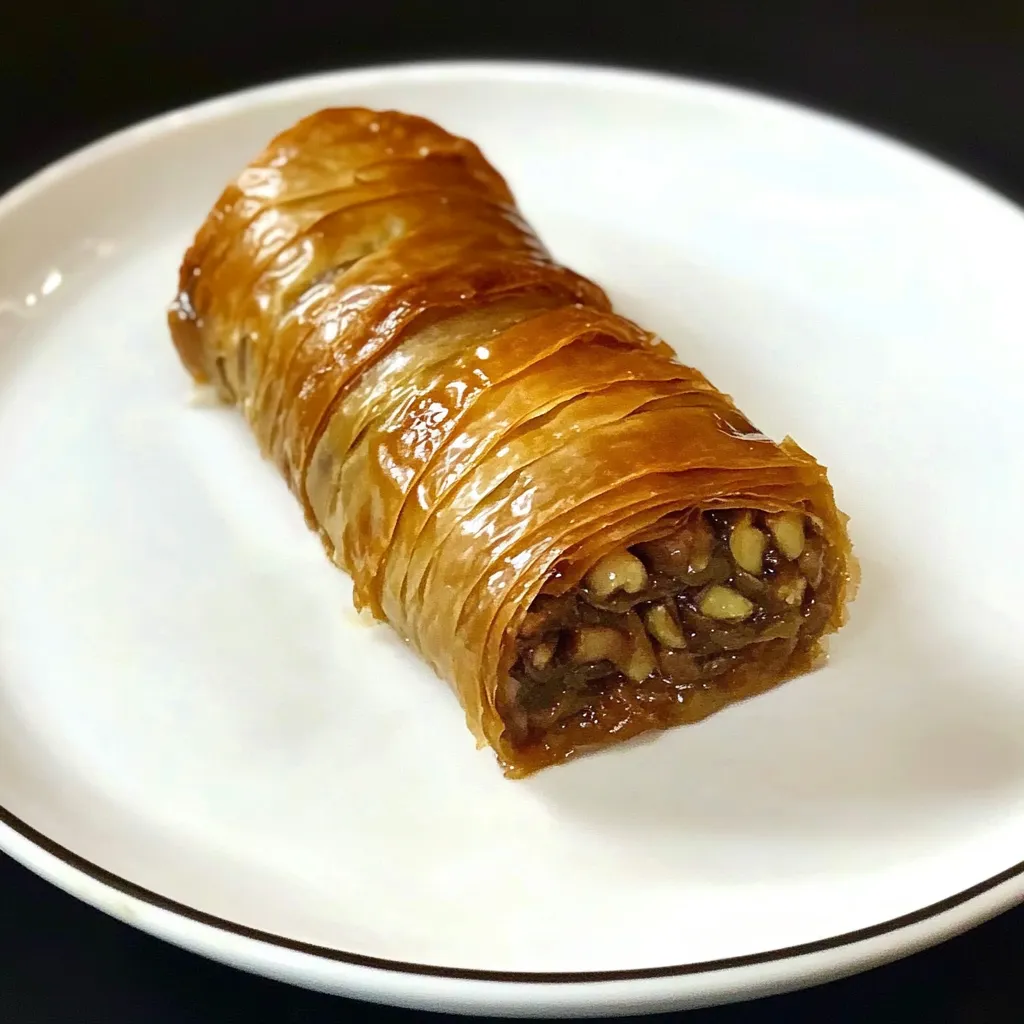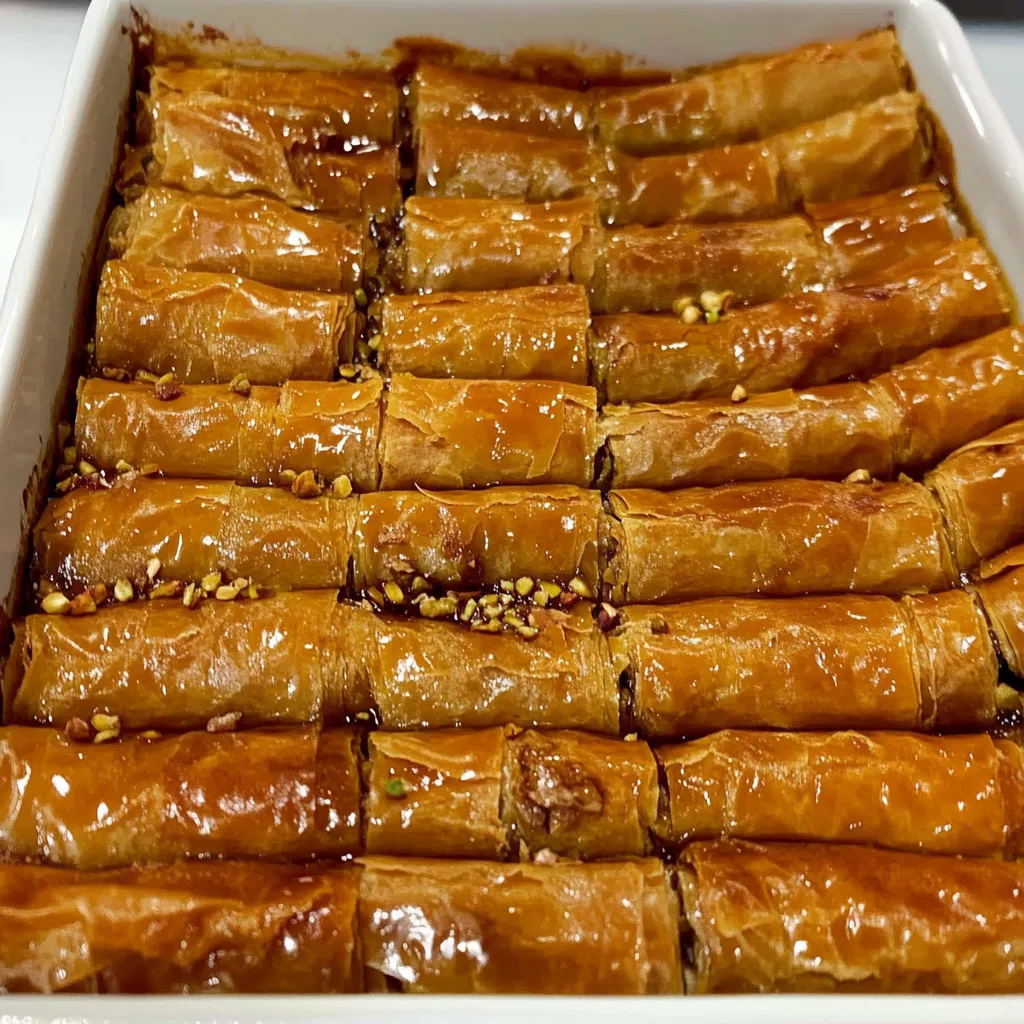 Pin it
Pin it
These crispy Greek baklava rolls, called Saragli, bring all the flavors of traditional baklava in a much simpler form. Instead of building endless layers in a pan, you roll buttery phyllo dough around spiced nuts to create individual portions that bake up golden and flaky. The secret is in the two-temperature baking method and pouring cold honey syrup over the hot rolls, which creates that perfect contrast of crispy outside and tender inside.
I discovered this rolled version during a trip to a Greek bakery, and it completely changed how I approach making baklava at home. The rolling technique might seem tricky at first, but once you get the hang of it, you can make a whole batch in half the time it takes for traditional baklava. My family actually prefers these rolls because each person gets their own perfect portion with the ideal ratio of nuts to pastry.
Essential Ingredients and Selection Tips
- Phyllo dough: Buy frozen sheets and thaw completely in the refrigerator overnight; fresh phyllo from Mediterranean markets works even better if available
- Mixed nuts (pistachios, walnuts, almonds): Choose raw, unsalted nuts and pulse them in a food processor until coarsely chopped, not powdered
- Quality honey: Greek or wildflower honey gives the best flavor; avoid processed honey that tastes too sweet
- Fresh spices: Grind whole cinnamon sticks and and cloves yourself for the most aromatic filling
- Unsalted European butter: The higher fat content creates flakier layers than regular butter
- Fresh lemon juice: Essential for balancing the sweetness and preventing the syrup from crystallizing
Detailed Step-by-Step Instructions
- Make the honey syrup first:
- In a heavy-bottomed saucepan, combine 1 cup sugar, 1 cup water, 1/2 cup honey, juice of half a lemon, 1 cinnamon stick, and 3 whole cloves. Bring this mixture to a rolling boil over medium-high heat, stirring constantly until the sugar completely dissolves. Once boiling, reduce heat to medium and simmer for exactly 3 minutes to allow the spices to infuse. Remove from heat immediately and set aside to cool completely - this step is crucial because hot syrup on hot pastry creates soggy results.
- Prepare your nut mixture thoroughly:
- In a food processor, pulse 1 cup each of shelled pistachios, walnuts, and blanched almonds until they're roughly chopped but still have texture. Transfer to a large bowl and mix in 2 teaspoons ground cinnamon, 1/2 teaspoon ground cloves, and 2 tablespoons raw sugar. The mixture should smell fragrant and hold together slightly when squeezed. Set this aside while you prepare your workspace.
- Set up your assembly station properly:
- Preheat your oven to 400°F (200°C). Generously butter a 9x13 inch baking dish, making sure to coat the sides as well. Melt 1 stick of butter and keep it warm in a small bowl with a pastry brush nearby. Remove the phyllo from its package and immediately cover the entire stack with a slightly damp kitchen towel - this prevents the delicate sheets from drying out and cracking.
- Master the rolling technique:
- Take one phyllo sheet and place it on a clean work surface with the long side facing you. Brush the entire surface lightly but evenly with melted butter, then place a second sheet directly on top. Brush this second sheet with butter as well. Sprinkle about 3 tablespoons of the nut mixture evenly across the phyllo, leaving a 1-inch border on all sides. Starting from the long side closest to you, fold up about 2 inches of the phyllo to create a straight edge, then place two wooden skewers parallel to each other along this folded edge.
- Create the signature crinkled shape:
- Roll the phyllo tightly around the skewers, keeping the nuts evenly distributed as you go. Once you've rolled the entire sheet, gently push the phyllo from both ends toward the center while the skewers are still inside - this creates the characteristic accordion-like wrinkles that give Saragli its distinctive appearance. Carefully slide out both skewers while maintaining the crinkled shape, then transfer the roll to your prepared baking dish. Repeat this process until you've used all your phyllo and nuts.
- Cut and finish before baking:
- Using a sharp serrated knife, cut each roll into 3 equal pieces while they're in the baking dish. This prevents the phyllo from unraveling during baking. Brush the tops of all pieces generously with the remaining melted butter, making sure every surface is coated for maximum golden color.
- Use the two-stage baking method:
- Bake at 400°F for exactly 15 minutes until the tops are light golden. Reduce temperature to 200°F (95°C) and continue baking for 35-40 minutes more. This low, slow finish ensures the inside cooks through while the outside becomes perfectly crispy without burning.
- Finish with the cold syrup technique:
- Remove the hot baklava from the oven and immediately pour the completely cooled syrup evenly over every piece. You should hear a satisfying sizzle as the cold syrup hits the hot pastry. Allow the rolls to sit uncovered for at least 2 hours so the syrup can penetrate the layers properly.
 Pin it
Pin it
Working with phyllo dough intimidated me for years until I learned that it's actually quite forgiving once you understand its quirks. My grandmother always said the key was to work quickly but not frantically, and she was absolutely right. The first few rolls might look imperfect, but by the time you finish a batch, you'll have developed a rhythm. My kids love helping with the crinkling step because it's impossible to mess up, and they get so excited watching the plain rolls transform into those beautiful accordion shapes.
Understanding Phyllo Dough Behavior
Phyllo dough is essentially paper-thin layers of flour and water that become incredibly flaky when baked with fat. Unlike puff pastry, which has butter laminated throughout, phyllo relies entirely on the butter or oil brushed between each sheet. This is why you can't skip the butter step or use too little - each layer needs that fat to separate from its neighbors during baking. The dough itself has no leavening agents, so all the lift and flakiness comes from steam created between the buttered layers.
When phyllo dries out, it becomes brittle and will crack the moment you try to fold it. However, slightly dried phyllo can often be rescued by covering it with a damp towel for 10-15 minutes. The moisture will redistribute, making the sheets pliable again. Professional bakers often work with phyllo at room temperature rather than cold, as it's more flexible and less likely to tear during handling.
The Role of Nuts in Greek Pastries
The combination of pistachios, walnuts, and almonds isn't just traditional - it's carefully balanced for both flavor and texture. Walnuts provide earthiness and slight bitterness that prevents the dessert from being too sweet. Almonds add a clean, mild nuttiness and help bind the mixture together. Pistachios contribute a distinctive flavor and that beautiful green color that makes the filling so visually appealing. Each nut also has a different oil content, which affects how the mixture holds together and how it tastes after absorbing the syrup.
Mastering Honey Syrup Consistency
The syrup for baklava needs to reach the right consistency to penetrate the layers without making them soggy. Too thin, and it won't add enough sweetness or stick to the pastry. Too thick, and it will sit on top instead of soaking through. The perfect syrup should coat the back of a spoon but still pour easily when cool. Adding lemon juice isn't just for flavor - the acid prevents the sugar from crystallizing and helps achieve that glossy finish.
Temperature Control for Perfect Results
The two-stage baking method serves a specific purpose beyond just cooking the pastry through. The initial high heat sets the butter-phyllo layers and begins the browning process. Reducing the temperature allows the inside to cook completely while preventing the outside from burning. This technique also helps drive out excess moisture, which is essential for achieving that crispy texture that makes baklava so satisfying to bite into.
After making hundreds of these rolls over the years, I've learned that the most important thing is not to overthink the process. Greek home cooks have been making variations of this dessert for generations without measuring every ingredient precisely or timing every step perfectly. The beauty of Saragli lies in its rustic charm - even slightly imperfect rolls taste absolutely delicious. My most memorable batch was actually one where several rolls unraveled slightly during baking, but they still disappeared within hours of coming out of the oven.
Frequently Asked Questions
- → Can I use frozen phyllo pastry for this recipe?
- Yes, just thaw it completely in the fridge overnight before using. Keep it covered with a damp towel while working.
- → How long do baklava rolls stay fresh?
- They keep well covered at room temperature for up to one week, but taste best within the first 3 days.
- → Can I substitute different nuts in the filling?
- Absolutely! Try hazelnuts, pecans, or cashews. Just keep the total amount of nuts the same as the recipe calls for.
- → Why do I need to pour cool syrup over hot baklava?
- The temperature difference helps the pastry absorb the syrup properly without making it soggy or tough.
- → What size baking dish works best for this recipe?
- A 23cm x 30cm dish fits perfectly, but you can use any similar sized rectangular baking dish that holds the rolls snugly.
- → Can I make the syrup ahead of time?
- Yes, the syrup can be made up to 3 days ahead and stored in the fridge. Just bring it to room temperature before using.
